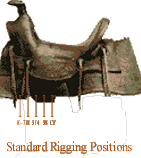|
or How best to attach the saddle to the horse. |

|
It's the rigging which provides saddle stability and security, better saddle fit, and greater comfort to the rider.
Rigging Nomenclature
The cinch (single rigging) or cinches (double rigging) tie to rigging rings, D's, or plates. The positions of these are specified relative to the saddle's fork and cantle.
Rigging is generally specified as Full Rigging, 7/8, 3/4, 5/8 and Center Fire, with the 7/8 being the most versatile and popular position. The rigging position determines where the saddle will sit on the horse's back as well as the position of the cinch will on the horse's belly.
 The rigging is defined by the position of the cinch from the cantle, from Full Rigging, the most forward position where the cinch ring or "D" lies directly beneath the center of the fork and horn, to Center Fire where the cinch ties in directly beneath the lowest point of the seat, midway between the cantle and fork.
The rigging is defined by the position of the cinch from the cantle, from Full Rigging, the most forward position where the cinch ring or "D" lies directly beneath the center of the fork and horn, to Center Fire where the cinch ties in directly beneath the lowest point of the seat, midway between the cantle and fork.
For a 7/8 Rigging your cinch would tie in at 7/8 of the distance from the cantle to the fork, 3/4 rigging at 3/4 the distance, and so on as illustrated in the picture at the left.

For events such as roping and cutting, Full Rigging is more appropriate. The Full Rigging position for a roping saddle, directly under the saddle horn, is shown in the picture at the right.
Double Rigging
Double rigging simply means you have two cinches, a front and a rear cinch. The further apart the cinches are the greater the stability of the saddle will be. A Full rigged saddle will almost always be double rigged as well.
A 7/8 rigging may be either single or double rigged depending upon intended use and rider preference.
In general -
- A -If you are getting a saddle strictly for pleasure riding, 7/8 single rigging will serve you well.
Better yet, a 7/8 double rigged saddle will give you greater versatility. You can use either only a front cinch or both front and rear cinches as you prefer.
(Use of only the rear cinch is not recommended, i.e., don't try this at home!)
- B - If your horse lover (or you) are into roping or other western events, you will want a saddle with Full Double Rigging.
So, you choice is basically narrowed to A or B unless someone who is in a position to give you sound advice suggests otherwise.
P.S. As we mention in several places in these pages about saddles -
if purchasing a saddle is something you have not done before, it's always a good idea to find an experienced horseperson who can give you assistance and advice in the matter.
